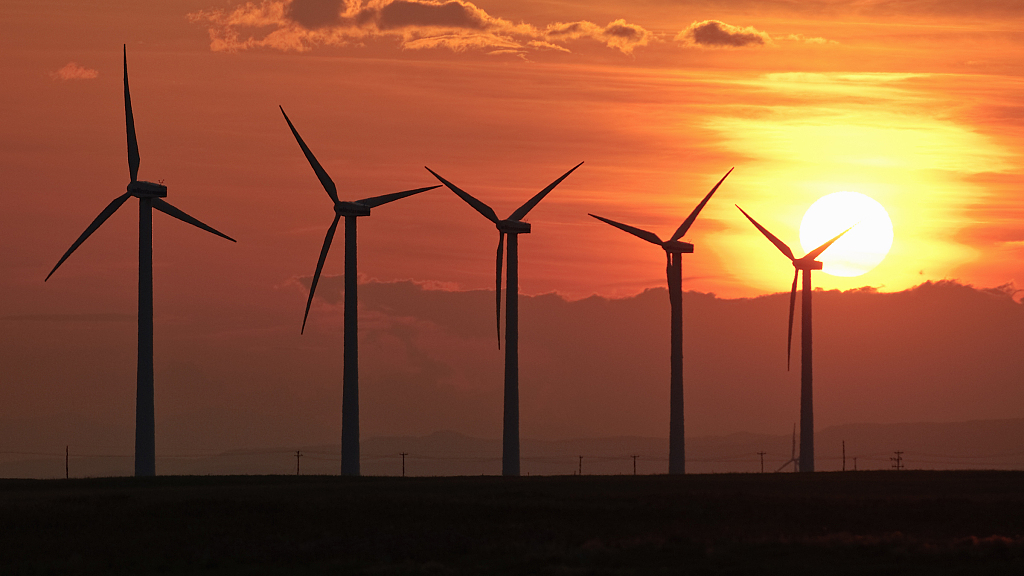
Editor's note: Patricia Espinosa, Chair of the Latin America and Caribbean Advisory Board of the Glasgow Financial Alliance for Net Zero, is a member of the Global Energy Alliance for People and Planet's Global Leadership Council. Lourdes Melgar, a research affiliate at the Center for Collective Intelligence at MIT, is a non-resident fellow at the Center for Energy Studies of the Baker Institute. The article reflects the authors' opinions and not necessarily the views of CGTN.
The world stands at a critical juncture in the fight against climate change. Either we drastically accelerate the clean-energy transition, or our fast-dwindling chances of preventing global temperatures from surpassing 1.5 degrees Celsius above pre-industrial levels will be destroyed. Few understand the stakes better than Latin American and Caribbean (LAC) countries.
These countries comprise one of the world's most climate-vulnerable regions. In the last year alone, the LAC region endured a destructive hurricane season, a deadly heat wave, and severe drought, which produced an acute water crisis in Uruguay and undermined hydropower production in countries like Ecuador. The credit-ratings agency Moody's estimates that climate change could cost the equivalent of 16 percent of the region's GDP this century.
But LAC countries also have vast potential to lead – and even propel – the global renewable-energy transition. As the International Energy Agency points out in its first Latin America Energy Outlook, renewables, led by hydropower, already account for 60 percent of the region's electricity – twice the global average – and some of the world's most robust wind and solar resources imply room for further growth. Latin America also possesses huge reserves of critical minerals vital to the clean-energy transition, including more than half of the world's lithium. And it is positioned to become a leader in the production and use of green hydrogen.
Moving onto a climate-safe trajectory will require radical, decisive, and immediate action, underpinned by global collaboration, strong political leadership, effective public-private partnerships, and well-designed regulatory frameworks. It will also require money: according to the IEA, the region must double renewable-energy investment by 2030.
This investment would deliver energy access to the approximately 17 million people currently living without electricity; avert 30,000 premature deaths through clean cooking; and create one million jobs in clean-energy industries. But, like any socioeconomic transformation, the clean-energy transition risks leaving some groups behind, with women, rural communities, and indigenous people most at risk. To avoid this outcome, climate initiatives – and the goals that underpin them – must reflect principles of justice and inclusivity.

The three-day 2023 Sao Paulo International Solar Photovoltaic Exhibition in Brazil concluded at the North Convention and Exhibition Center in Sao Paulo, Brazil, August 31, 2023. /VCG
The three-day 2023 Sao Paulo International Solar Photovoltaic Exhibition in Brazil concluded at the North Convention and Exhibition Center in Sao Paulo, Brazil, August 31, 2023. /VCG
The energy transition depends on infrastructure. Latin America's existing energy infrastructure has been built largely to support the production and consumption of oil and gas. To facilitate the development, storage, distribution, and transmission of renewables, the region must now build more interconnected grids and expand supportive infrastructure on land and at sea. Greater cross-border connectivity and scalable storage systems are essential to ensure that renewables-based systems across Latin America can withstand the worsening effects of climate change.
Costa Rica offers a model for how this can be done. The country is undergoing a profound transformation across every facet of its economy in an effort to become the world's first carbon-neutral country by 2050. In 2020, the Inter-American Development Bank modeled over 3,000 potential futures for Costa Rica and found that it would meet or almost meet its net-zero ambitions in over 75 percent of them – in nearly half, it predicted that the country would go even further, reaching net-negative emissions.
Other LAC countries are similarly well-placed to reduce their reliance on fossil fuels, decarbonize their economies, and enhance their energy security. To this end, they should be developing their renewable-energy capabilities and working to boost energy efficiency. The Glasgow Financial Alliance for Net Zero is helping here by working with local financial institutions to bolster climate finance in the region – an example of how public-private partnerships can help deliver sustainability and prosperity for all.
Of course, strategies will differ across countries. In the Caribbean, the climate, geography, and topography complicate the generation and transfer of renewable energy. Distributed generation – meaning that electricity is generated near the point of use – is one way to overcome these challenges.
The Global Energy Alliance for People and Planet has already begun deploying this technology in the region. In Haiti, for example, Global Energy Alliance for People and Planet (GEAPP) is supporting the creation of mesh grids – decentralized modular grids that enable households to generate most of the energy they consume with solar panels but are also connected to their neighbors in power-sharing clusters. By combining the simplicity, accessibility, and cost-effectiveness of solar home systems with the resilience of a grid, mesh grids can deliver cost-effective energy access in remote areas.
Battery energy storage systems – rechargeable batteries that can store energy from different sources – are another important technological solution. By helping to stabilize the electricity grid and ensure a reliable power supply during the energy transition, Battery Energy Storage Systems (BESS) can help countries to reach their renewable-energy goals while boosting their economies and lifting people out of generational poverty. Already, the global BESS market is on track to double in size by 2030. GEAPP's BESS Consortium is working to ensure that the benefits of this technology are felt across all income levels.
The journey to a sustainable future will be a long one, involving continuous investment and innovation. New energy-storage solutions, together with enhanced regional connectivity, will form the backbone of a robust, resilient, and modern energy infrastructure. Meanwhile, as LAC countries recognize, projects will have to be designed and implemented with social justice and the inclusion of indigenous communities in mind.
The LAC region is committed both to mitigating climate change and ensuring climate justice. With effective public-private partnerships and concerted investments that support a strong supply chain, the region can achieve the energy revolution that its people – and the world – need.
Copyright: Project Syndicate, 2023
(If you want to contribute and have specific expertise, please contact us at opinions@cgtn.com. Follow @thouse_opinions on Twitter to discover the latest commentaries in the CGTN Opinion Section.)



